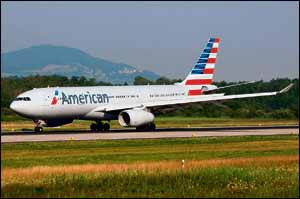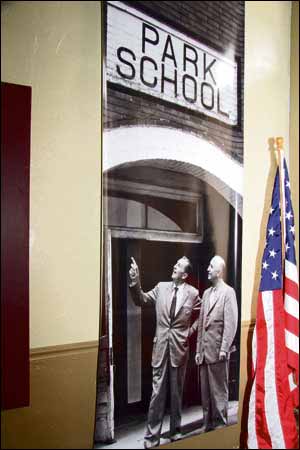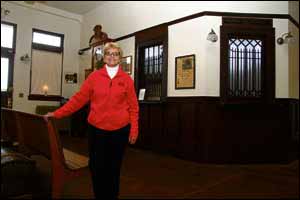 | ||||||
| The Dreaming Tree, Rupert the horse... and magic of Disney | ||||||
The Magic Dreaming Tree, starring Rupert the horse, sounds like the title of Disney film. It isn’t, but it could well be.
In the backwaters of Marceline, in Missouri, America, in a field behind a former farmhouse, sits the sad, charred stump of a once proud cottonwood tree which, two years ago, finally succumbed to disease and numerous lightning strikes. But the little, old lady who lives in the pretty farmhouse makes a daily wish that the special tree might magically come back to life and start to spring green shoots once again. Every day, come rain or shine, she visits it and talks to it, willing it back to life. It was a very special tree, under whose spreading limbs the dreams of a little boy who once lived in the house really did come true as he lay in that Missouri field. When the tree grew old and sick and eventually fell to the ground, it seemed to be a sad ending rather than the happy denouement of a Disney film. But some magicians from the America Forest Tree Nursery had woven their own spell in 2004, taking 1.5 million seeds from it. When the tree died, Cottonwood Junior was miraculously born, after the seeds were planted just yards from where their illustrious father still lies. Water to nurture it came from the Rivers of America and soil for its roots from the Magic Kingdom in Florida.
When the little boy who used to live in the farmhouse grew up, he shared with hundreds of millions of people all over the world the magical animals and characters that remained in his memory. That little boy was Walt Disney, and he never forgot where he came from, despite achieving fame and untold riches. Marceline would always be home for him. He arrived there, aged four-and-a half. His family had no electricity or running water, but he recalled: “More things of importance happened to me in Marceline than have happened since, or are likely to in the future. “My best memories are the years that I spent here.” He lived in Marceline until he was nine, but those four years of his childhood left a deep impression, before the Disney family moved to Kansas City, 125 miles away. From an early age, he and his older brother Roy used to walk through the woods and encounter foxes, possums, raccoons, woodpeckers, cardinals and wild doves — wildlife which years later would be recreated as cartoons in full technicolor, on the big screen, as Walt recalled the joys of his childhood. Disney could never forget the magical, carefree days he spent swimming in a cow pasture pond and his adventures riding on a pig called Skinny. He also trained a rooster to crow on command by bribing it with pancakes. He and Roy would play beneath the large cottonwood tree and when he had achieved fame and fortune, he would return occasionally to his beloved tree and ask to be left alone to sit beneath it. Nearby, the barn in which the brothers used to play was also immortalised in Disney’s 1949 film, So Dear to my Heart, set in the early part of the 20th century, the period of Walt’s own childhood. The set was built precisely according to his own recollection of the barn in which he enjoyed so many happy times.
Visitors to Marceline can wander freely past the sad cottonwood stump and enter the barn. It was there that Walt probably learned his first real lesson in the entertainment business — one he never forgot. Aged nine, he staged a circus of sorts and charged the neighbourhood children 10 cents each to attend. It consisted of a goat, a pig and the family dog dressed in his sister Ruth’s clothes. By the end of the performance, the audience was singularly unimpressed and his mother, Flora, made him refund all the money, telling him: “If you deliver more than your audience expects, they will never be disappointed.” Young visitors, too, have the opportunity several times a year to draw or paint Rupert the horse, from the same blood line as the original Rupert which a local doctor asked Young Walt Disney to draw for him. It was in Marceline that Disney saw his first film, a silent movie depicting the crucifixion of Jesus. It was in Marceline, too, that he saw his first live show, Peter Pan, at the local college and even caught his first fish there. His parents, Elias and Flora, had moved the family from crime-ridden Chicago and bought 45 acres of land just outside the town where the former’s brother owned property. Elias farmed for the first time in his life and the entire family helped him, recalled Kaye Malins, who has lived in Marceline all her life. “When Walt saw his first harvest,” Kaye told me, “he saw how all the neighbouring farmers worked as one. “Walt always recalled that and said, ‘We should always work as one’.” Today, their farmhouse at 100 West Broadway is owned by Kaye who is also executive director of the Walt Disney Home Town Museum. She inherited the house from her father, local businessman Rush Johnson, who had originally acquired it for Disney himself.
The new Disney film, The Great Locomotive Chase, was being premiered at the Uptown Theater. “Walt and Roy stood outside and greeted every child that went into the theatre,” remembered Kaye, herself then an eight-year-old child. “When Walt took the stage that day he said, ‘You children are lucky to live in Marceline. My best memories are the years I spent here’.” Walt and Roy explored their old haunts and, at the school, Walt even found the desk on which he had carved his initials as a child. Walt stayed at Rush’s newly-built home, after town officials had asked him to host the film mogul, since it was one of only three properties in Marceline with air conditioning. “After everything was over, he and I retired to our den,” Johnson recalled and, what became known as ‘The Marceline Project’ was born. Johnson added: “First thing he asked me was ‘Rush, who owns the Disney family farm?’ I told him and he said, ‘You can buy it cheaper than I can. Buy it’.” Walt said: “There will come a time when a child won’t know what an acre of land is, or what happens when you plant seeds in the ground.” Kaye said: “Walt wanted a 1900s working farm. He wanted to celebrate his rural heritage. “He was possibly looking at it as a larger business venture.” After Walt died, never having developed what was known as Crane Farm, Roy, who was running the company, decided not to continue some of the projects they had planned, including those in Marceline. He sold the property to Rush who in his lifetime passed it on to Kay who still lives there.
He picked the brains of people he had known during his childhood, visited his former school and took pictures of youngsters at play. He photographed Main Street, which, Kaye says, seemed like a reference for Disneyland. He also took cine film of the creamery where his mother used to sell butter, his family farm and his beloved Dreaming Tree. Walt had always loved watching the trains pass through Marceline. In 1998, Rush Johnson and three other residents were so upset by the derelict state of the railway station and booking office, built in 1913, that they bought the building for $80,000 to save it. “They just loved Marceline,” Kaye said. ”They had no plans for it.” The interior had been ripped out but the original plans were discovered, by chance, in Topeka, nearly 200 miles away. The railway building is now the Walt Disney Home Town Museum. Today, the booking office looks pretty much like it did when it opened and some of the 3,000 items, bequeathed by Walt’s sister, Ruth, are displayed there. A staggering 35,000 people attended the opening on November 10, 2001, the day after the terror attack on New York’s World Trade Centre. Organisers had feared the public would stay away. These days, as many as 70 trains, some up to three miles long, thunder past the old station on the Santa Fe line, never stopping as they did in Walt’s day. Still, though, they give the three warning toots because the tracks are entirely open, with no protection.
Visitors to the museum are transported back to a time when a little boy’s love of animals and nature in a small Missouri town resulted in him creating a magical world of escapism for children the world over. Allegations of antisemitism dogged Walt Disney throughout his lifetime and persisted after he died, aged 65, in December, 1966. Kaye Malins is adamant he was not. “He had Jewish people working for him,” she offered as evidence. Walt Disney Home Town Museum: www.waltdisneymuseum.org Miss Vic’s Corner Cafe in Main Street is a must for hearty soups, home-made pies for dessert and Dusty Miller Ice Cream. Further information on Missouri, www.visitmo.com Flights from Manchester to St Louis on American Airlines start at about £841. Visit www.aa.com For meet and greet parking at Manchester and other UK airports www.looking4parking.com Car hire cost around £98 for three days and was arranged through www.rentalcars.com
|





